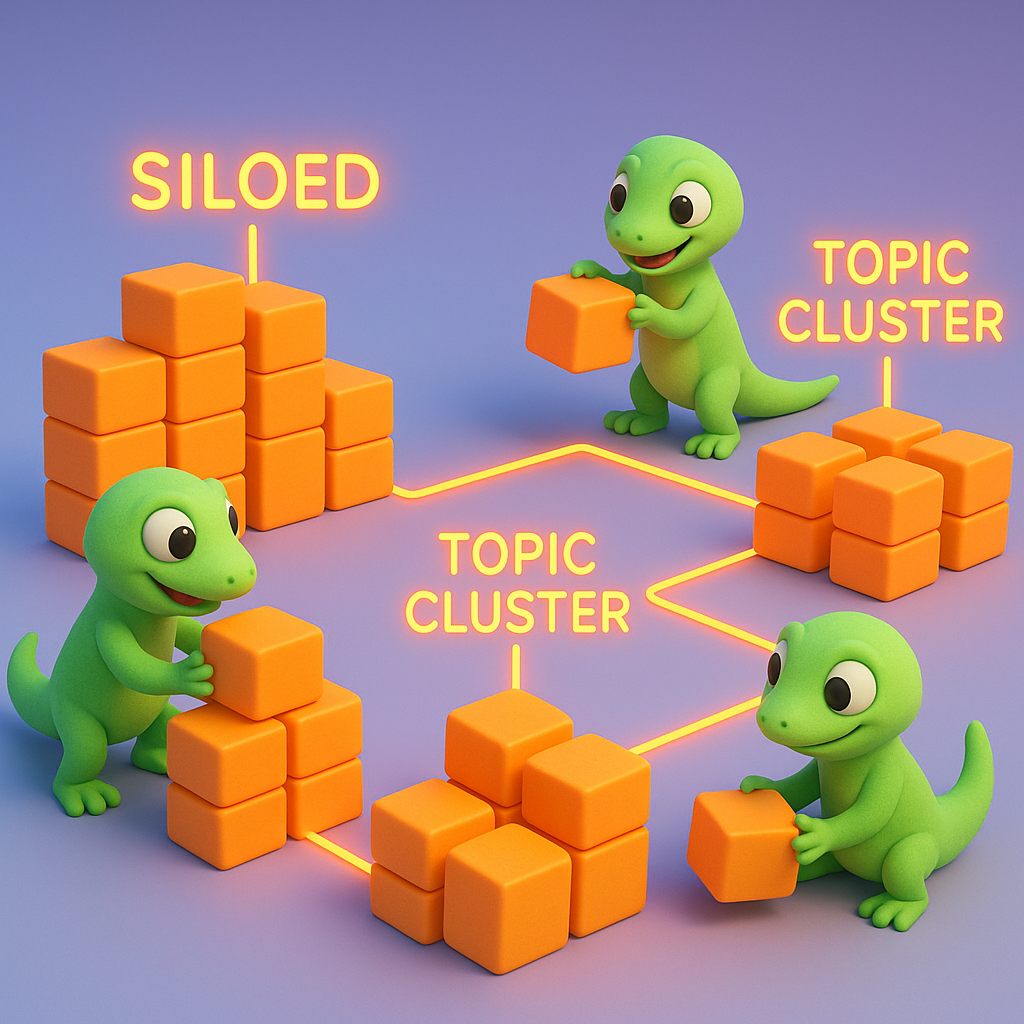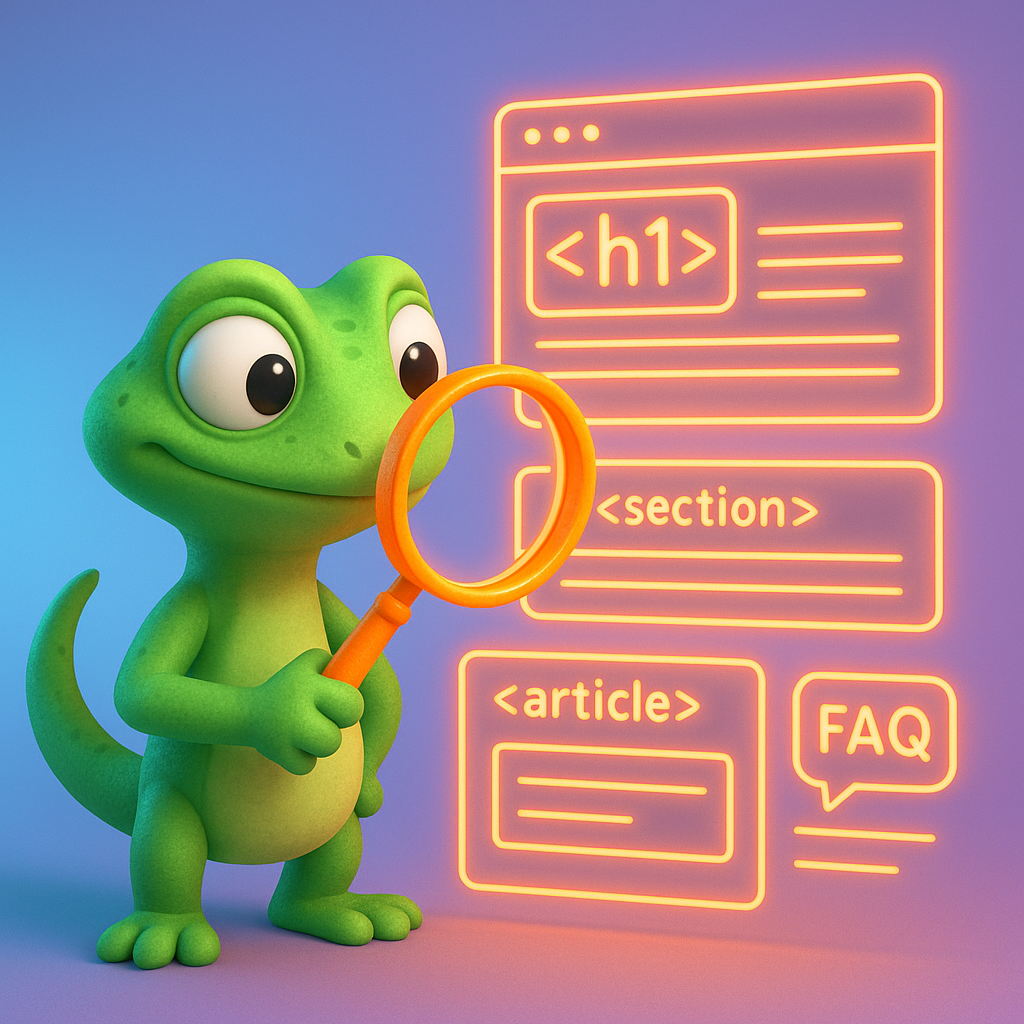Adapting Website Architecture for LLM Search
The search landscape is transforming fundamentally as large language models (LLMs) reshape how users discover information. Traditional SEO tactics focused on keywords and backlinks still matter, but they’re no longer enough. Website architecture needs specific adaptations to remain visible and relevant in AI-powered search engines.
Core Architectural Shifts for LLM Search
Siloed Architecture & Topic Clustering
LLMs prioritize content organized in thematic clusters that demonstrate topical authority. According to BackLinko research, siloed architecture significantly improves keyword rankings by strengthening contextual relevance.

Implementation tactics:
- Group related content into distinct topical hubs
- Create pillar pages that comprehensively cover broad topics
- Link cluster content to pillar pages to establish semantic relationships
- Flatten navigation to reduce content depth (keep important pages within 3 clicks of homepage)
For example, a SaaS company might create a comprehensive pillar page on “Customer Retention Strategies” with cluster content addressing specific subtopics like “Retention Metrics,” “Churn Prevention,” and “Customer Success Programs” – all interlinked to reinforce topical authority.
Intent-Based Structure vs. Keyword Structure
LLM search interprets user intent via context, not just keywords. Research shows intent-based clustering reduces manual effort by 80% while improving relevance by 40%.
Key restructuring approaches:
- Reorganize content around user intent groups rather than individual keywords
- Create dedicated sections for different query types (how-to, comparison, definition)
- Use a free keyword clustering tool to group semantically related keywords
- Prevent keyword cannibalization through logical content organization
Consider how an e-commerce site selling running shoes might restructure from keyword-based pages (“best running shoes,” “running shoes for men,” “cheap running shoes”) to intent-based sections (“Buying Guides,” “Comparison Tools,” “Maintenance Tips”) that address the deeper questions behind searches.
Internal Linking for AI Comprehension
Internal linking patterns significantly impact how AI crawlers understand your site’s information hierarchy and topical relationships.
Best practices:
- Prioritize semantic relationships over keyword-based anchor text
- Implement breadcrumb navigation for clear content hierarchies
- Avoid orphaned pages that remain invisible to AI crawlers
- Link related content based on conceptual connections, not just keyword matching
Think of your internal linking strategy as creating a knowledge graph that AI can navigate. For instance, linking from “Sustainable Manufacturing Processes” to “Carbon Footprint Reduction Methods” creates a semantic connection that helps LLMs understand your site’s topical expertise even when exact keywords don’t match.
Technical Optimization for LLM Visibility
Schema Markup & Structured Data
Schema markup is no longer optional—it’s essential for LLM comprehension. According to m8l.com, implementing specific schema types dramatically improves AI’s ability to parse and feature content.
Critical schema types:
- FAQPage (for Q&A content)
- HowTo (for step-by-step guides)
- Article (for news and blog content)
- Speakable (for voice-optimized answers)
The implementation of schema markup provides explicit signals to LLMs about the nature and structure of your content. For example, FAQPage schema directly identifies questions and their corresponding answers, making this information readily available for AI to extract when responding to user queries.
Semantic HTML Implementation
The actual HTML structure of your pages communicates meaning to AI systems, impacting their interpretation of your content.

Key elements:
- Use proper heading hierarchy (
<h1>through<h6>) to establish content importance - Implement
<section>,<article>, and<header>tags to clarify content structure - Utilize definition lists, tables, and ARIA labels for enhanced readability
- Structure content with dual-purpose in mind: human readability and machine comprehension
Semantic HTML serves as the foundation for machine understanding. When you properly structure a comparison table using <th> and <td> elements instead of just formatting text to look like a table, you’re helping AI systems understand the comparative relationship between items.
Rendering & Indexability Optimization
LLMs struggle with JavaScript-heavy pages. According to Vercel’s research, server-side rendering (SSR) and static site generation (SSG) significantly improve AI crawling and comprehension.
Implementation strategies:
- Prioritize static HTML delivery over client-side rendering
- Implement SSR/SSG for JavaScript-heavy applications
- Ensure Core Web Vitals meet Google’s standards (LCP <2.5s, INP ≤200ms, CLS <0.1)
- Optimize mobile experience as AI engines prioritize mobile-friendly content
Consider the case of a JavaScript-heavy SPA (Single Page Application): while it might provide an excellent user experience, its content remains largely hidden from AI crawlers if it relies solely on client-side rendering. Implementing Next.js or similar frameworks with SSR capabilities ensures that AI systems can access your content just as effectively as human visitors.
Content Strategy Adjustments for LLM Search
Conversational Format & Question-Answer Structure
LLMs excel at retrieving content structured as direct answers to user questions. This natural Q&A format aligns with how users interact with conversational AI interfaces.
Implementation tactics:
- Structure content with natural language questions as headers
- Provide direct, concise answers immediately following questions
- Create comparison tables for products or concepts
- Anticipate and address follow-up questions within content
This approach mimics the way people naturally seek information. When a financial services site structures a page about retirement planning with questions like “How much should I save for retirement?” followed by clear, concise answers, it’s not only helpful for human readers but perfectly aligned with how LLMs retrieve information.
Dual-Structured Content Approach
Content must serve two purposes: providing concise answers for featured snippets while offering comprehensive information for users seeking depth.
Best practices:
- Begin sections with concise definitions or answers
- Follow with detailed explanations and supporting evidence
- Use structured data markup to highlight key information
- Create content that balances brevity with comprehensive coverage
This dual approach satisfies both quick-answer seekers and those needing in-depth information. For example, a healthcare site might begin a section with a concise definition of a medical condition, followed by detailed information about symptoms, causes, and treatments—serving both the snippet-seeking AI and the knowledge-hungry human reader.
Authoritative Content Development
LLMs prioritize content that demonstrates expertise, authority, and trustworthiness (E-A-T). Harvard Business Review reports that 58% of consumers now use generative AI for recommendations, making authoritative content crucial.
Enhancement strategies:
- Include bylines from credentialed experts
- Provide transparent citations and references
- Update content regularly to maintain accuracy
- Use a content writer generator that can incorporate expert research and opinions
Authority signals matter significantly in LLM retrieval. A medical article written by a board-certified physician with current research citations is much more likely to be surfaced by AI systems than generic, unattributed content on the same topic.
Measuring LLM Search Performance
New Metrics Beyond Traditional SEO
Traditional SEO metrics like keyword rankings don’t fully capture LLM search performance. New measurement approaches are needed.
Key metrics to track:
- AI citations and brand mentions in LLM responses
- Content retrieval rates in AI search engines
- AI-specific conversion paths and attribution
- Featured snippet capture rates
For example, monitoring how often your brand or content is cited in AI responses to relevant queries provides a direct measurement of your visibility in LLM search that traditional rankings can’t capture.
Tools for Monitoring LLM Visibility
Specialized tools help track performance across emerging AI search platforms.
Recommended tools:
- Tools for monitoring LLMO performance that track citation frequency
- Analytics platforms with AI search referral tracking
- Structured data testing tools to verify implementation
- Content quality measurement systems that align with LLM preferences
These specialized tools fill the gap left by traditional SEO platforms that haven’t yet adapted to the LLM search landscape. They help marketers understand how well their content performs in AI-mediated discovery contexts.
Comparative Strategies: Traditional SEO vs. LLM Optimization
Understanding the differences and complementary nature of traditional SEO and LLM optimization is crucial for developing an effective strategy.
Key distinctions:
- Traditional SEO focuses on explicit ranking signals while LLMO prioritizes semantic understanding
- Keyword targeting shifts to intent-based content clustering
- Backlink quality remains important but content authority becomes paramount
- Technical optimization expands to include LLM-specific elements like schema and semantic HTML
This isn’t an either/or proposition—the most effective approaches combine elements of both. For instance, maintaining strong technical SEO fundamentals while enhancing content with intent-focused structure and schema markup creates a site that performs well in both traditional and LLM-powered search.
Implementation Roadmap
Quick Wins for Immediate Impact
Some architectural changes can deliver rapid improvements in LLM visibility.
Priority actions:
- Implement FAQ schema markup on existing content
- Structure high-traffic pages with clear headings and Q&A format
- Add semantic HTML tags to improve content hierarchy
- Enhance internal linking between topically related pages
These quick wins offer substantial benefits without requiring massive resource investment. For example, a B2B software company might see significant improvements in AI search visibility simply by implementing FAQ schema on their most visited support pages.
Long-Term Architectural Transformation
Comprehensive website architecture adaptation requires systematic change.
Strategic approach:
- Conduct a site-wide content audit to identify thematic clusters
- Develop a siloed architecture plan with pillar and cluster content
- Implement schema markup across all relevant content types
- Establish ongoing monitoring of LLM search performance
This systematic transformation aligns your entire site with LLM search patterns. While more resource-intensive, it positions your organization for sustainable visibility as AI-mediated discovery becomes increasingly dominant.
TL;DR
Website architecture for LLM search requires fundamental shifts from traditional SEO approaches. Key adaptations include implementing siloed topic clusters, intent-based content organization, enhanced schema markup, and semantic HTML structure. Success depends on balancing technical optimization with authoritative, conversational content development while measuring performance with new LLM-specific metrics. As ContentGecko demonstrates, companies implementing these changes can achieve significant organic traffic growth even as search behavior continues to evolve toward AI-mediated discovery.
